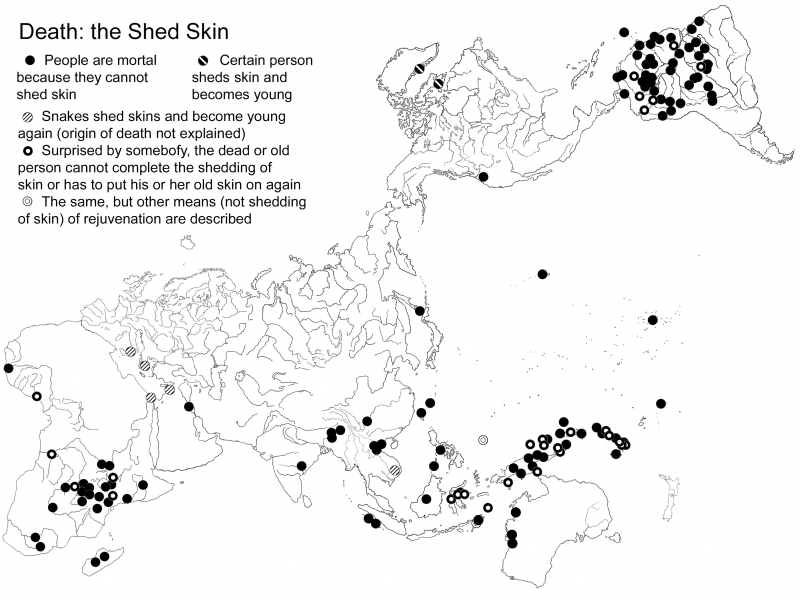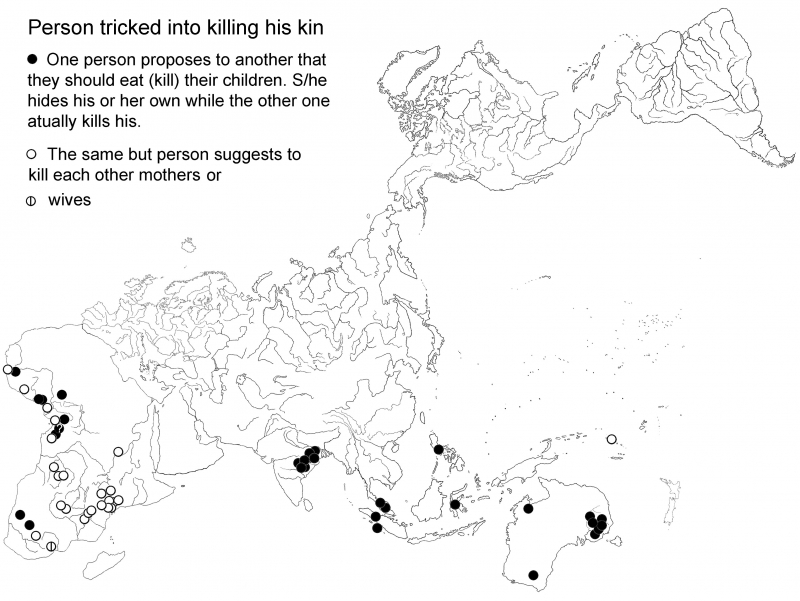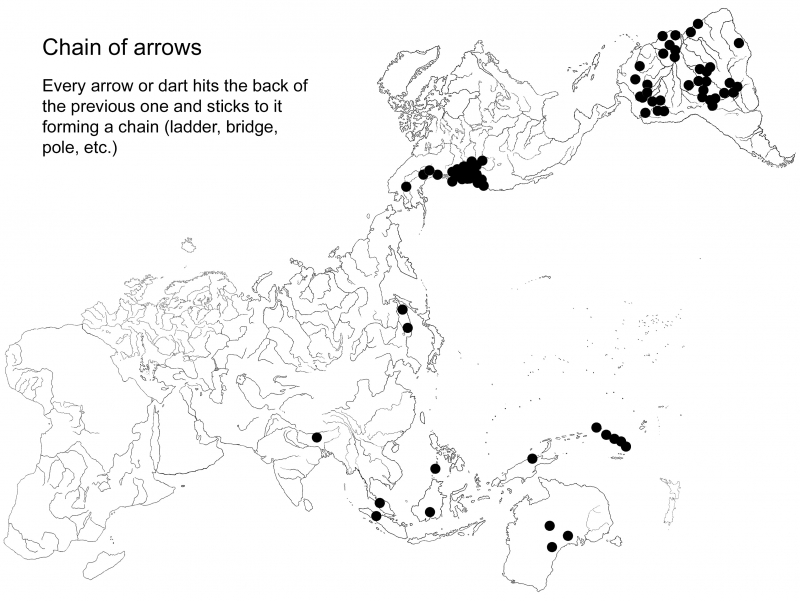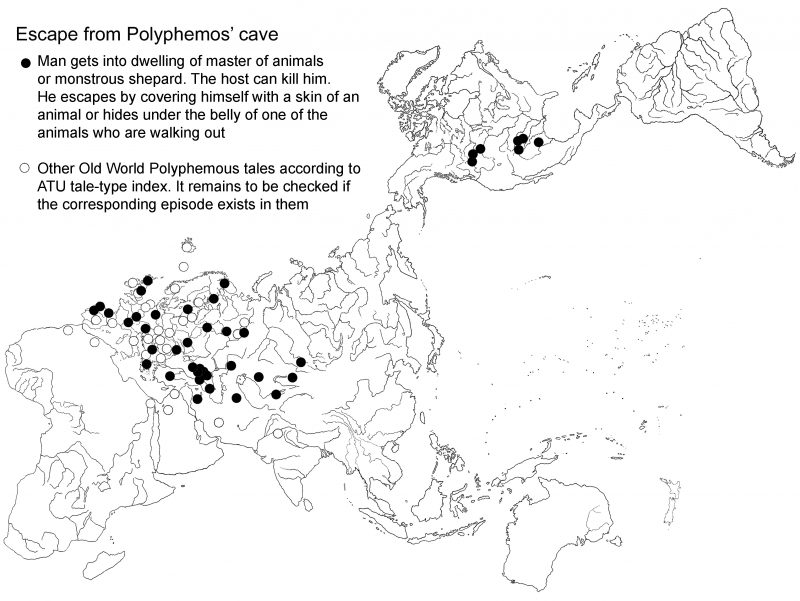The dispersal of modern man and the areal patterns of folklore-mythological motifs
This paper is prepared on the base of the electronic Catalogue of the folklore-mythological motifs that contains information on the world distribution of about 1500 motifs. Information from ca. 5500 publications in Germanic, Slavic, Romance and Baltic-Finnish languages have been extracted. List of motifs with English wordings and maps of their areal distribution see at <http://starling.rinet.ru/kozmin/tales/index.php?index=berezkin>. More than 40,000 Russian abstracts of texts are available at <http://www.ruthenia.ru/folklore/berezkin>. The financial support was provided by the Russian Foundation for Basic Research (projects 04-06-80238 and 07-06-00441-a), special programs of the Presidium of Russian Academy of Sciences “Adaptation of peoples and cultures to environmental changes, social and technogenic transformations” and “Historical-cultural heritage and spiritual values of Russia” and by INTAS project 05-10000008-7922.
Our Catalogue is not another general index of tale-types or motifs. It has been created not to register whatsoever narrative units but with a particular aim to accumulate data relevant to research on early migrations and prehistoric cultural contacts. Initially the problem of the peopling of the New World was in focus of studies. After about 2003 when the materials from Western Eurasia and Africa had been included, even earlier periods of human history could be addressed. The major results of previous research, exposed in several papers in English (Berezkin, 2002a and 2009b) and in Russian, is as follows.
Our motifs are any episodes, chains of episodes, structures, images, etc., that are subject to replication and found in more than one text. Franz Boas and his colleagues were selecting similar units for their research (e.g. Boas, 2002, pp. 662–74; Kroeber, 1908; Swanton, 1929, pp. 269–75) though they never coined a specific label for them, naming them “elements”, “catch-words”, etc. I am not sure that the term “motif” is right decision because I mean something different from S. Thompson’s (1951, p. 415) definition but unfortunately no other suggestion has been better. The existence of the motifs is not realized by people who retell their texts. Just because of this such elements have opportunity of being transmitted between generations and populations with only minor and chance modifications. Both elementary (Thompson, 1955–1958) and complex motifs can be used for the purpose of historical research. Some complex motifs find equivalents in the Aarne-Thompson-Uther tale-types (Uther, 2004) though rarely quite complete ones and in many cases they have no such correspondences at all.
For purposes of comparative analysis, motifs must receive precise definition. Otherwise the inclusion of a particular case in a given series would depend on the subjective opinion of a researcher as about how near or distant a particular narrative is to the sample one. Elements of the texts, which do not correspond precisely to definition elaborated by the researcher, are not included into the database. Distantly similar cases should be either ignored or a new motif with such a wording to which all corresponding cases answer exactly should be created. If we claim that a given text contains a particular motif, we mean that it contains all combinations of episodes or sets of images mentioned in the wording of this motif.
In the late ’90s the computing of data on areal distribution of about 1000 mythological motifs checked for the American Indians and the Eskimo demonstrated the existence of two main sets of motifs. One of them was best represented in Amazonia and Guiana and another across the Plains and around the Great Lakes. The mythologies of these regions proved to be the most different from each other. As our database acquired world-wide dimensions, it became clear that these American mythological complexes corresponded to the similar complexes in the Old World.
Some tendencies are especially apparent if we minimize the “entropic” effect of the Western Eurasian fairy-tale and compute only cosmological and etiological motifs which are relatively rarely adopted into the fairy-tale to be introduced with it to new territories. Some other tendencies can be better understood when we address just the motifs of adventure which had been adopted into the fairy-tale from more archaic Eurasian folklore.
The folklore-mythological traditions that share the lest number of motifs are located one in continental Eurasia, especially in Southern Siberia, and another in Melanesia, especially across the New Guinea. The sets of motifs in Melanesia and Amazonia are statistically identical. The North American mythologies are more similar to the Southern Siberian ones than the South American mythologies. The traditions of the southeast borderlands of Asia are also intermediate between continental Asian and Melanesian complexes.
The two major sets of motifs of world mythology were named the Continental Eurasian and the Indo-Pacific. The mythologies of sub-Saharan Africa are relatively poor in cosmological and etiological motifs. Because of this they stand not far from the zero position between the two extremes but still nearer to the Indo-Pacific than to the Continental Eurasian pole.
Such a picture fits perfectly the Out-of-Africa scenario of the peopling of the world by modern man suggested by the genetists and ever more supported by archaeologists. Ca. 60,000 bp groups of Homo sapiens, the so called “beachcombers”, crossed a narrow strait between Africa and Arabia and began to move along the coast of Indian Ocean. At the Middle East this stream split. Some groups continued their movement to the east till Australia and East Asia while others migrated in northern direction and eventually occupied about the same part of Eurasia where the Neanderthals lived before. The Indo-Pacific mythology preserved the African heritage that is evidenced by the links between tale-producing motifs recorded in Africa, non‑Aryan India, Southeast Asia and Australia. The distribution of motifs Shed skin as condition of immortality (figure 1) and Person is tricked into killing his kin (figure 2) provide good illustrations.
Figure 1. – Areal distribution of motif Shed skin as condition of immortality.
It is an example of African motif spread across all Indo-Pacific part of the Globe but remained unknown in Continental Eurasia and in the New World preserved mainly in South America.
Figure 2. – Areal distribution of motif Person is tricked into killing his kin.
It is an example of African motif brought to South and Southeast Asia and to Australia.
In Continental Eurasia the African mythology was largely lost. It could happen soon after peopling of the sub-glacial zone with its very different environment in comparison with the tropical homeland and certainly during the Late Glacial Maximum (LGM) when population density in Northern Eurasia decreased. Though during the LGM population survived in the periglacial forest steppes of the southern half of Siberia including Angara and Aldan basins, the more northern tundra areas were empty (Kuzmin and Keates, 2005). Those groups that successfully adapted themselves to the changed climatic conditions certainly underwent deep cultural transformation. All this contributed to the idiosyncratic deviations from former tradition. This founder effect created the new mythology (i.e. the new set of motifs) that was very different from the Indo-Pacific one. Since about 18‑19,000 bp when the acme of the LGM was over, the Continental Eurasian set of motifs probably became to disseminate thanks to the progressive expansion of survived population. The 18‑19,000 bp dating of the beginning of recovery from LGM populational minimum is based on the dating of Dyuktai culture in Eastern and Northeastern Siberia (Yi and Clark, 1985, p. 10) and for assessment of time for repeopling of the Northeast Europe by human groups of probable Southern Siberian origin (Pavlov, 2009).
Mythology of the Southeast Asia and adjacent areas preserved its African roots though it also was changing during the Upper Pleistocene. In comparison with African mythologies, the mythologies of the Indo-Pacific borderlands of Asia are richer and this enrichment had to take place between the initial peopling of these territories by Homo sapience and the beginning of the peopling of the New World. Accordingly, during the Late Pleistocene the difference between the Indo-Pacific and the Continental Eurasian complexes was increasing. At about 15,000-12,000 bp both sets of motifs were brought to the New World and mixed there. The Indo-Pacific complex became predominant in South and Central America (figure 3) while Continental Eurasian complex became represented mainly in North America, especially to the east of the Rockies (figure 4). The mixing of the two complexes could begin already in Siberia because the East Asian groups probably took part in its peopling after the LGM.
Figure 3. – Areal distribution of motif Chain of arrows.
It is an example of Indo-Pacific motif brought into the New World and preserved in South America and in the North American northwestern region across which the earliest migrants probably moved.
Figure 4. – Areal distribution of motif Escape from Polyphemos’ cave.
It is an example of Continental Eurasian motif brought to the New World not along the Northwest Coast but probably across Yukon and Mackenzie valleys and preserved mainly across the Plains. The Kazakh version in which the ogre is not a shepherd but the master of wild animals are the most similar to the American Indian ones.
The most responsible part of our hypothesis is the assumption that ca. 60,000 bp, i.e. before the modern humans began their migration to Asia, their language was developed enough to retell stories about mythical beings, the primeval ancestors. However, the global patterns in distribution of motifs strongly evidence in favor of such a conclusion. The mythology of the first out-of-Africa migrants was not especially developed—seven to nine different explanations of the mortal nature of man, some tales about the Sun and the Moon, possibly some simple ideas about the Milky Way, the Pleiades and the Belt of Orion, the origin of people from under the earth or from the sky, some the animal stories. The cores of all the adventure stories which are widespread in Africa now were probably brought there later from Asia.
Cluster of motifs related to the image of Magic wife, i.e. of a supernatural female who married a mortal man can be classified under category of “adventure motifs” though sometimes they are incorporated into etiological myths that explain the origin of people in general or of particular ethnic groups, lineages, etc. The Magic wife is one of the most widespread themes of world folklore, but it is only rarely found in sub-Saharan Africa and was probably brought there relatively recently (at least in post LGM times) from Asia. For Australian mythologies the very situation of a marriage between the supernatural and the mortal is irrelevant because in Australian narratives all the participants are neither totally human nor non‑human but the “primeval ancestors” of mixed nature. Stories about the marriage of a male from the earth with a female from the sky who eventually abandons him are also rare (practically only one case is recorded (Parker, 1897, pp. 43–6], in all others the male only tries to catch the female but fails). As about the occurrence of the Magic wife in Eurasia, Oceania and America, the areal patterns of particular variants of this theme demonstrate clear tendencies that help to define the place and to a certain degree the time of their emergence.
Sky-maiden variants with a special attention to the Swan-maiden narratives
Putting together all Magic wife variants in which supernatural marriage partner is connected with upper world is somewhat formal. It’s not obvious that Star‑wife and Duck‑wife have more in common than either of them with e.g. Fish-wife or Elk-wife. However, such a combination works, i.e. as far as we select as a separate category all tales about the marriage of human person with a female from Upper world, there are easily noticed tendencies in the areal distribution of particular variants classified in such a manner (figure 5).
Figure 5. – Areal distribution of motif Sky-maiden.
In folk taxonomies all big or middle-sized birds which swim or live near water and regularly migrate to the south in big wedge-shaped flocks (swans, geese, ducks, cranes) are grouped together (cf. German “Zugvögel” [Toivonen, 1937]). Accordingly, in narratives they are more easily replaced with each other than with images of other kind. We will be naming all narratives with participation of corresponding personages “Swan-maiden” stories even if they are really about Duck-maidens or Crane-maidens. Besides very rare cases in Latin America (Heron-woman in Sierra Popoluca and Shikrin Kayapo and Duck-woman in Mocovi texts) and in Indonesia (Goose-woman in Minahasa text), all Swan-maiden variants of the Magic wife are found across the continuous area of Northern Eurasia and adjacent part of North America. In North America they are known to the Eskimo-speaking, Tlingit and Haida groups. Considering this pattern of distribution, the Swan-maiden must be of North Eurasian origin and be brought to New World after the end of the LGM. Practically no other (i.e. not Swan-maiden) variants of the Sky-maiden are known in areas where the Swan-maiden is widespread. In Western Siberian Khanty story daughters of the Sun-woman are not named swans but they probably have this appearance because the hero who tries to approach them unrecognized has to put on the swan skin (Lukina, 1990, no. 5, p. 65). The most numerous and elaborate versions of the Swan-maiden which explain the origin of particular groups of people are found among the Buryats of Baikal region, almost exclusively among the Khori group of Buryats (Barannikova, 1973, no. 1, pp. 43–53; Eliasov, 1973, no. 64, pp. 312–7; Khangalov, 1960, no. 99, pp. 105, 109–11, 379–80; Nassen-Bayer and Stuart, 1992, p. 327; Poppe, 1981; Potanin, 1883, pp. 23–5; Rumiantsev, 1962, pp. 146–201; Sharakshinova, 1959, p. 136; Id., 1980, pp. 130–1; Tugutov and Tugutov, 1992, no. 46, 47, 49, pp. 157–63; Zabanov, 1929, pp. 29–31).
To the south of the area of the Swan-maiden, there is a vast area of a less specified Sky-maiden stories that occupies East and Southeast Asia and western Oceania. Female protagonists of these stories are non-migratory birds (like Cassowary in Papuan myths), Stars, or anthropomorphic sky nymphs that are not directly associated with any particular animals or objects. If the two areas, the Northern Eurasian and the Southeast Asian ones, are historically connected (and the adjacent position of the both zones in respect to each other suggests that they are), which of the variants is the oldest and which is derived from the other?
Arguments in favor of the priority of the less specified images are twofold, related to the areal distribution of variants and to their content.
Almost all Latin American Indian versions are of the same kind as the Southeast Asian versions. They too demonstrate great variety of the Sky-maiden identification (Vulture, Parrot and other birds, Star-woman, unspecified sky-nymphs). As it was told above, Latin American Indian mythologies have many correspondences with the mythologies of the Pacific borderlands of Asia and Oceania, probably derived from them and represent the heritage of early groups of migrants into the New World. Unlike the Latin American Indians, the Eskimo are unanimously considered as the latest arrivals to the New World. The fact that the Swan-maiden is widespread just among the Eskimo but known to most of the American Indians means that before the arriving of the Eskimo-speaking groups into American Arctic (probably ca. 5000 bp [Fitzhugh, 2002, p. 123]), the Swan-maiden in Siberia or at least in the Northeast Asia was unknown. The Tlingit and Haida stories hardly have independent Siberian sources but are related to the Eskimo ones. In all of them (Eskimo, Tlingit and Haida) the Sky-maiden is Goose while in Eastern Siberia it is Crane, Swan or Duck. The only and rather far away from the Bering Strait area case of the Goose-maiden is among the Amur Evenk (Bulatova, 1980, pp. 102–4). The Northwest Coast Indians could borrow the Goose-maiden story from Pacific Eskimo or from the bearers of Kachemak culture that occupied the same territory of Southern Alaska before ad 1000-1200 (Crowell, a.o. 2001; Dumond, 2005; Klein, 1996). The Kachemak tradition is not related directly to the historic Eskimo and can go back to the Ocean Bay culture that appeared on Kodiak and the nearby coast of Alaska Peninsula at about 5500 bc. However, Kachemak is definitely more closely related to the Aleutian and Paleo-Eskimo traditions than to any Amerindian ones.
The hypothesis of historic priority of the Southeast Asian versions of the Sky-maiden is supported by their usual or at least very often integration into the actual mythological beliefs. Across the southeast borderlands of Asia the motif in question is not used only in adventure stories with anonymous protagonist which is typical for the Northern Eurasian Swan-maiden variants but also into antropogenic myths. These are the cases of Arapesh Papuans, Dayaks of Brunei, Bantic of Sulavesi, Tidore of northern Moluccans, inhabitants of Sangir and Nufoor Islands, Nabaloi of Luzon (Gregor and Tuzin, 2001, pp. 325–6; Knappert, 1999, pp. 299–301; Lessa, 1961, pp. 124, 148–9, 154–6; Moss, 1924, no. 26, pp. 259–61). Other stories do not explain the origin of people but still contain different etiological motifs like the origin of gods, celestial bodies, atmospheric phenomena, human anatomy and culture, etc. (Maori, Gonds, Austronesian people of Borneo, Yava, Sulavesi and the Philippines, the Chinese [Braginski, 1972, pp. 117–21; Elwin, 1949, no. 3, p. 176; Eugenio, 1994, no. 142, pp. 256–7; Gomes, 1949, pp. 278–300; Hatto, 1961, pp. 328–9; Kruyt, 1938, no. 40, pp. 390–1; Lessa, 1961, pp. 148, 153–4; Macdonald, 2005, p. 96; Rassers, 1959, pp. 266–7; Reed, 1999, no. 5, 8, pp. 58–74, 86–90, 210–1; Rybkin, 1975, no. 38, pp. 105–11; Wilhelm, 1921, no. 16, pp. 31–4]). In Latin America, the origin of people is explained in the Sky-maiden myths of the Lacandons, Cabecar, Maina, Caraja, Tapirape, probably Wayana and other Indians (Baldus, 1952–1953, pp. 210–1; Id., 1970, p. 355; Boremanse, 1986, pp. 242–6; Id., 1989, pp. 91–3; Ehrenreich, 1891, pp. 39–40; Grenand, 1982, no. 5, pp. 69–72; Stone, 1962, pp. 59, 63; Verneau and Rivet, 1912, pp. 34–5; Wagley, 1977, p. 176]. In Northern Eurasia and in North America, however, no other Swan-maiden story besides the Khori-Buryat ones is related to the explanation of the origin of people.
Narratives in which the Sky-woman is a dove deserve special attention. We can find such an identification in Indonesia, China and Latin America but only as rare and chance variants among other cases of the identification of the sky-woman with a bird. But from the Mediterranean till Xinjiang, i.e. mainly across the area of Islamic influence, the Dove-maiden is a predominant version of the Sky-maiden used in the fairytales. It seems likely that the spread of this version was late and connected with the spread of the fairytale as a particular folklore genre.
Conclusions
Differences in the areal distribution and content of Northern Eurasian – Arctic American Swan-maiden stories and much more diversified tales from the Southeast and East Asia, Oceania and Latin America can be explained considering the demographic and cultural history of Eurasia and America after the Late Glacial Maximum. I suppose that the plot of Sky-maiden (and possibly of the Magic wife in general but this needs special investigation) developed during the Paleolithic in Pacific borderlands of Asia before LGM. In continental Asia before the LGM it could be unknown. After the end of the LGM there had to be a general population movement to the north as far as ever new areas of Northern Eurasia became suitable for habitation (there are some direct genetic evidence in favor of such a movement but it is a theme apart and we do not address it now). Eventually, the people of Eastern/Southeastern Asian origin entered Beringia and ultimately American mainland. Their heritage has been preserved mainly in Latin America. In Northern Asia one particular version of the Sky-maiden, i.e. the Swan-maiden, was adopted by local populations and spread across Siberia and further into Europe, mostly into its eastern and northern part. It happened rather late because the Old World ancestors of most of the Northern American Indians had not yet known the Sky-maiden and therefore could not bring it to the New World. Even the less specified Sky-maiden tales are rare among North American Indians. At the time when the Eskimo ancestors became to move into the New World, the Swan-maiden myth was already well developed and it spread with the Eskimo across American Arctic. This way we have approximate dating of the emergence of the plot between 10/12,000 and 5000/6000 years bp. The Sky-maiden remained extremely rare in Africa, the existing cases probably borrowed from Asia through the trade contacts in East Africa. To the south of the forested zone of Eurasia (Mediterranean – Central Asia), the Sky-maiden was probably introduced very late with the fairytale.





